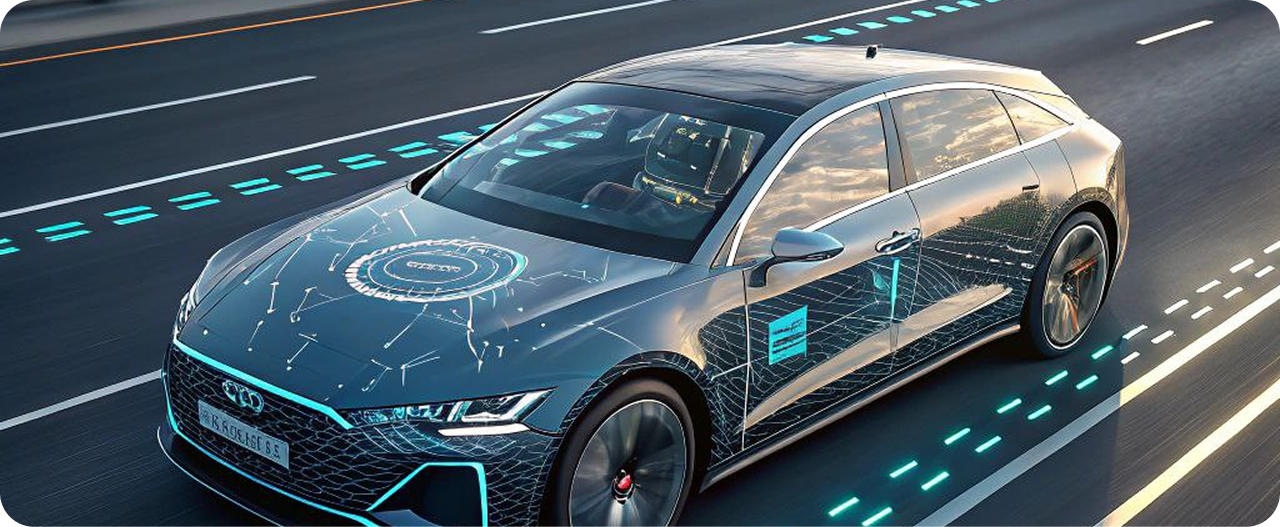
The Role of AI in the Automotive Industry
12 min read
Artificial Intelligence (AI) is playing a crucial role in shaping the future of the automotive industry, starting with the way vehicles operate. From powering advanced driver-assistance systems to enabling fully autonomous driving, AI enhances road safety, reduces human error, and leads to smarter mobility. Beyond the driving experience, AI also supports predictive maintenance, helping vehicles detect and address issues before they lead to costly repairs; This makes vehicles more reliable for both everyday drivers and large fleets.
The impact of AI doesn’t stop there.In automotive manufacturing, it improves efficiency at every stage — from optimizing supply chains to monitoring quality on production lines. This means vehicles are built faster, with greater precision and fewer errors. At the same time, dealerships are beginning to embrace AI-driven tools that transform how cars are sold. Tools like car sales AI , intelligent lead follow-ups, and 360° vehicle photography make the process smoother for both buyers and sellers. Customers get a clearer, more personalized view of their options, while dealerships save time and operate more efficiently. Taken together, these innovations show that AI is already transforming every step of the automotive journey; from manufacturing to driving to sales!
How is AI Used in the Automotive Industry?
AI in Manufacturing and Supply Chain (predictive maintenance, robotics, QC)
Artificial Intelligence (AI) has become essential in modern automotive manufacturing. Predictive maintenance, for example, relies on sensors and machine learning to identify equipment wear before it leads to costly breakdowns, reducing downtime and saving costs.
On the assembly line, AI-powered robots take over repetitive tasks with speed and accuracy, improving both efficiency and worker safety.
On the assembly line, AI-powered robots take over repetitive tasks with speed and accuracy, improving both efficiency and worker safety.
At the same time, computer vision systems inspect parts in real-time, catching defects that human eyes might miss. In supply chains, AI forecasts demand, manages inventory, and reroutes shipments to keep production on track. Together, these technologies enable automakers to produce vehicles more quickly, with higher quality, and with fewer interruptions.
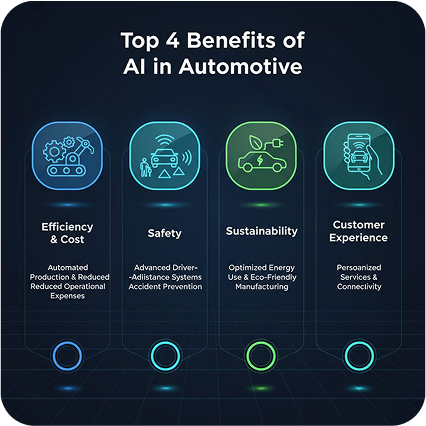
AI in Vehicle Design & Engineering (simulation, testing, lightweight materials)
Designing a vehicle involves thousands of complex decisions, and artificial intelligence (AI) is making this process faster, smarter and more effective. Engineers now use AI-driven simulations to test aerodynamics, safety, and fuel efficiency before a prototype is ever built. Machine learning models can run millions of virtual crash tests, significantly reducing the time and cost of traditional physical testing. AI also helps discover and optimize lightweight materials helping manufacturers create cars that deliver better performance while reducing emissions. These innovations allow automakers to bring vehicles to market more quickly, with designs that are safer, stronger, and more environmentally friendly.
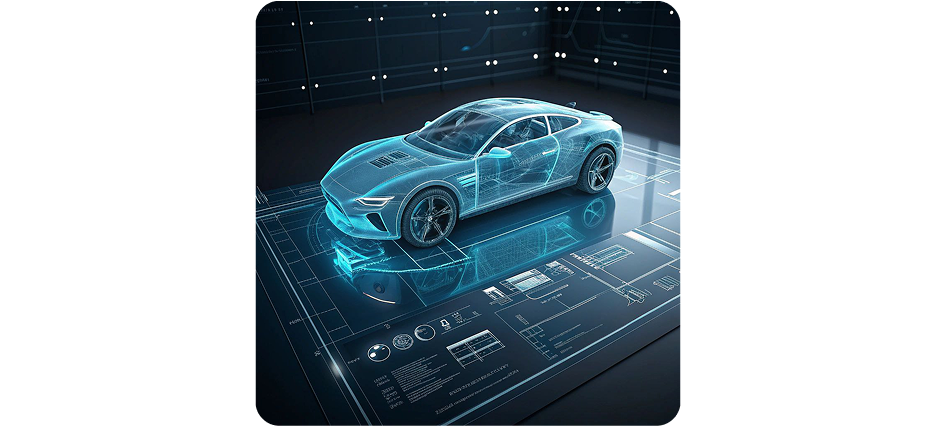
AI in Autonomous Driving & Advanced Safety Features (ADAS, driver monitoring, computer vision)
Self-driving technology is one of the most visible uses of AI in the automotive industry. Advanced Driver-Assistance Systems (ADAS) already use AI to support features like lane-keeping, adaptive cruise control, and emergency braking. Computer vision helps vehicles recognize pedestrians, cyclists, and road signs in real time. Driver monitoring systems powered by AI can detect drowsiness or distraction, alerting the driver before an accident occurs. As AI continues to improve, these systems are not only making cars and driving safer but also laying the foundation for fully autonomous vehicles.
This rapid progression toward autonomy was highlighted by Fortune.com:
”Elon Musk is banking on exponential growth of self-driving cars and humanoid robots to make Tesla the most valuable company in the world.”
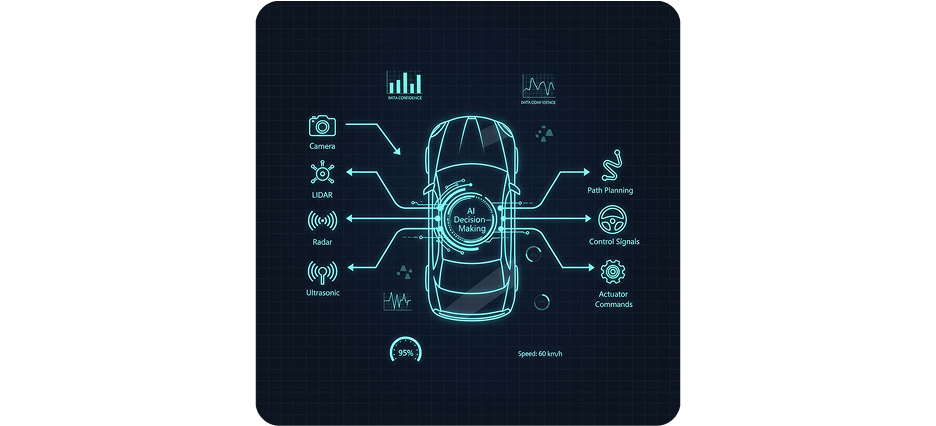
AI in Car Sales and Customer Experience (chatbots, personalization, dealership efficiency)
AI is also transforming car sales, making the process more efficient and customer-friendly. Many dealerships now use AI-powered chatbots to provide instant answers to buyer questions, whether about financing options, vehicle availability, or specific features; reducing wait times and improving responsiveness. Recommendation engines personalize the shopping experience by suggesting cars that match a customer’s budget, preferences, and lifestyle. For dealerships, AI tools automate scheduling, inventory tracking, and customer follow-ups, which means staff can focus on building stronger relationships instead of repetitive tasks. The result is a smoother sales process that saves time and creates value for both customers and dealerships. As Car Dealer Magazine quotes:
”It dealt with over 60,000 leads last year … saved deals with 13% of its customers that any human salesperson would have given up on.”
Michael Ben - CEO of Available Cars
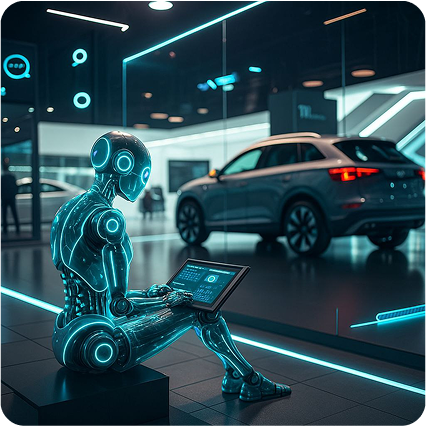
Lead Scoring and CRM Automation
One of the most powerful uses of AI in dealership sales is lead scoring. Instead of treating every inquiry equally, AI analyzes customer behavior, online interactions, and past purchases to rank leads by their likelihood to buy. This helps sales teams focus on high-potential customers first. Integrated with CRM systems, AI can automate reminders, emails, and follow-ups, ensuring no lead slips through the cracks. This data-driven approach boosts conversion rates while reducing the manual effort required from sales staff.
AI-Powered 360° Car Viewing and Virtual Showrooms
Buying a car is a big decision, and customers often want to see every detail before visiting a dealership. 360 car photography makes this possible by showing the car inside and out online. Traditional methods for creating 3D models are expensive, take a long time to edit, and require moving cars to studio booths, which is complicated and costly.
By contrast, AI solutions streamline the process, delivering high-quality interactive visuals much faster without any equipment. Some platforms even build virtual showrooms with augmented or virtual reality, letting customers “walk around” vehicles from anywhere. The result is a more engaging and transparent online shopping experience that helps buyers feel confident in their decisions.
AI in Dealership Marketing
AI is also transforming how dealerships market their inventory. Instead of generic ads, AI analyzes browsing patterns, demographics, and search behavior to deliver highly targeted campaigns. For example, a customer researching electric cars might see personalized ads for specific EV models available at local dealerships. AI also optimizes ad budgets by automatically choosing the best platforms and times to run campaigns. This ensures dealerships get the most value from their marketing spend while reaching the right audience.
Real-World Applications and Examples of AI in Automotive
Tesla, Waymo, BMW, Toyota, and Other Innovators
Some of the most advanced uses of AI in the automotive industry are already on the road today. Tesla integrates AI into its Autopilot and Full Self-Driving systems, using computer vision and deep learning to process road data in real time. Waymo, a leader in autonomous driving, relies on AI-powered sensors and mapping to operate self-driving taxis in select cities. BMW applies AI not only in driver assistance but also in its factories, where intelligent robots and predictive maintenance keep production running smoothly. Toyota uses AI in both vehicle design and safety systems, combining machine learning with advanced simulations to improve performance. These companies highlight how AI is moving from concept to practical reality across driving, manufacturing, and customer experience.
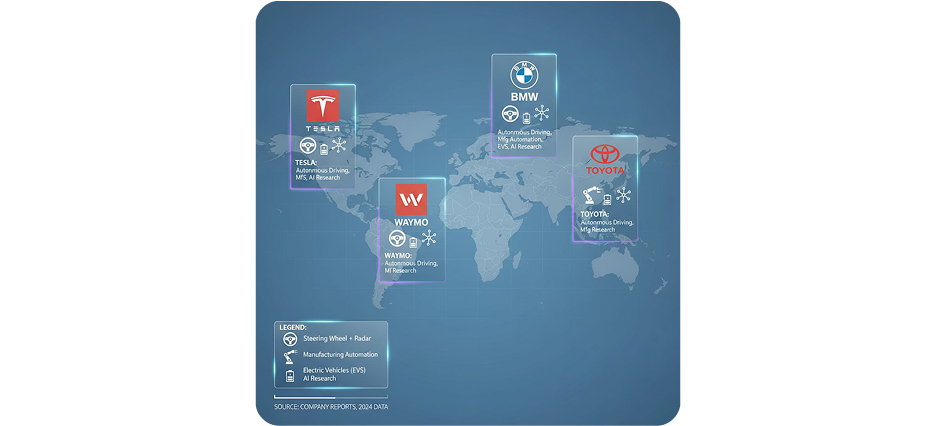
AI in Dealerships (inventory management, customer experience)
AI is also transforming how dealerships market their inventory. Instead of generic ads, AI analyzes browsing patterns, demographics, and search behavior to deliver highly targeted campaigns. For example, a customer researching electric cars might see personalized ads for specific EV models available at local dealerships. AI also optimizes ad budgets by automatically choosing the best platforms and times to run campaigns. This ensures dealerships get the most value from their marketing spend while reaching the right audience.
For inventory management, AI systems can provide a comprehensive and centralized dashboard, offering a real-time overview of every vehicle. Whether it’s available, already sold, financeable, or even how popular it is with buyers. AI algorithms analyze historical sales data, customer preferences, and seasonal demand trends to predict which vehicles and parts will be in high demand.
For example, Cox Automotive reports that AI-driven inventory tools can cut excess stock by up to 30%, freeing up capital and speeding up sales. Some dealerships also use AI-powered pricing tools that pull in millions of data points from auctions, competitor listings, and consumer behavior to suggest fair and competitive prices automatically.
On the customer side, AI chatbots handle questions, test drive schedules, and vehicle recommendation. From loan options to vehicle features and follow up at the right time to keep buyers engaged. Recommendation engines suggest cars that match a shopper’s budget and preferences, guiding them toward better decisions without pressure. In fact, a study by Accenture found that 75% of car buyers are more likely to purchase from a dealer that offers personalized digital interactions.
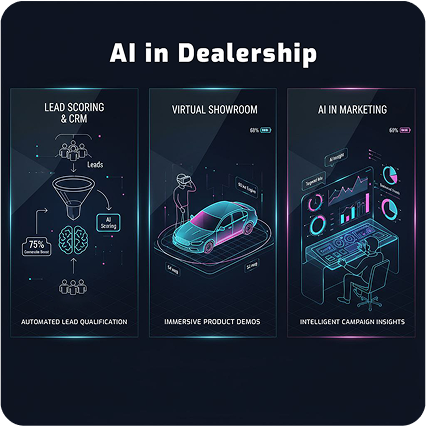
Emerging Areas Where AI is Driving the Future of Cars
AI in Connected Cars and Vehicle-to-Everything (V2X) Communication
In connected cars, AI + V2X allow vehicles to communicate with other cars, traffic signals, and road infrastructure. For example, Cooperative Adaptive Cruise Control (CACC) uses V2X to adjust speed not just based on what’s immediately in front, but also the acceleration or deceleration of vehicles further ahead; this helps smooth traffic flow and reduce collisions.
Companies like Link Motion also integrate V2X, cloud diagnostics, and over-the-air updates into the “carputer” platforms that enable real-time telemetry and remote monitoring.
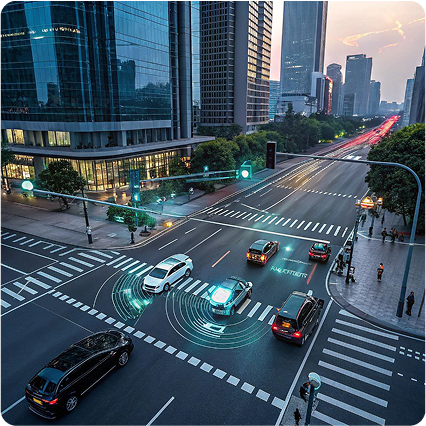
AI in Electric Vehicles (EVs) for Battery Management and Range Optimization
EV battery systems increasingly rely on AI for managing state of charge (SoC), state of health (SoH), and optimizing range. A study by Stanford shows that incorporating real-world driving data (temperature, driving patterns, charging behaviour) into battery management algorithms helps make batteries more reliable and longer-lasting.
- Stanford News
Another example: Electra Vehicles’ EVE-Ai system cut estimation error of battery range significantly compared to industry-standard methods like Extended Kalman Filtering.
- Business Wire
Also, NXP’s recent cloud-connected Battery Management System (BMS) with digital twin technology reported improvements in SoH estimation and battery performance, pointing to gains of around 12% in health metrics.
- eBOM
AI in Automotive Cybersecurity (fraud detection, threat prevention, secure driving)
As cars get more connected, the risk of cyber threats rises. AI is playing a crucial role in detecting anomalies in vehicle data streams, preventing fraud, and securing car systems. For example, Callisto’s AI-powered Vehicle Security Operations Center monitors logs continuously to spot potential threats and reduce false-alarms (for instance, distinguishing unusual door behavior vs. normal usage) to improve safety.
Another case: Smart Eye uses computer vision and deep learning to monitor driver behaviour—detecting distraction or drowsiness—and works on hardware that preserves privacy (doesn’t store unnecessary video) while still keeping vehicles safer.
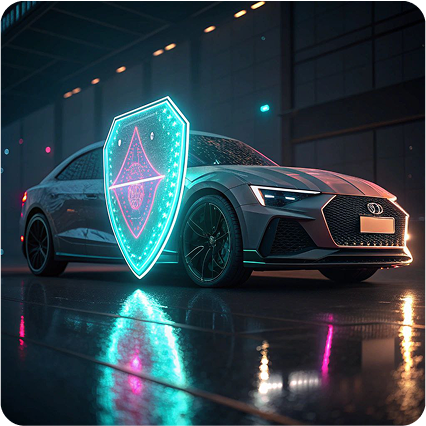
The Future of AI in the Automotive Industry
By 2030 and beyond, AI is set to reshape what owning a car means, how people move around, and what they expect from mobility. According to McKinsey up to 25% of total automotive revenues could come from shared mobility and connectivity services; meaning companies won’t just sell cars, they’ll also sell time, access, and service.
“The new base case could mean that business in the personal-mobility landscape may look very different in the future. Value is likely to shift toward new, disruptive business models, with shared mobility and connectivity solutions potentially accounting for up to 25 percent of total automotive revenue in 2030.“
McKinsey & Company
Vehicles with at least Level 2 autonomy are predicted to make up a majority of new car sales by 2030, and fully autonomous zones and robotaxi fleets will become much more common in urban areas. EV subscription services—bundling charging, updates, and battery maintenance—are expected to grow rapidly, with markets growing at a ~28.6% CAGR leading into 203
For customers, AI will make the driving experience more personal and seamless. Cars will act like mobile devices, learning driver preferences, suggesting routes, and even handling routine tasks like parking or maintenance scheduling. Instead of just being vehicles, cars will become intelligent companions—connected to homes, workplaces, and city infrastructure. This shift marks a move from cars as products to cars as part of a larger mobility ecosystem.
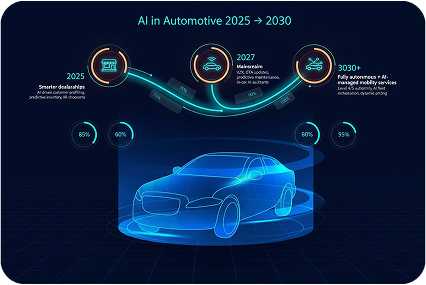
FAQs on AI in the Automotive Industry
What is the best AI for automotive?
There isn’t a single “best” AI for the entire industry, since different systems are built for different purposes. For example, NVIDIA and Qualcomm provide platforms for autonomous driving, while companies like Microsoft and Google supply cloud AI for connected services. In dealerships, companies like Drivee build AI for sales automation, chatbots, and inventory management. The best AI depends on whether it’s being used for driving, manufacturing, or sales.
How is AI used in the automotive industry today?
AI is already used in several areas. On the road, it powers advanced driver-assistance systems (ADAS), lane-keeping, and emergency braking. In factories, AI supports predictive maintenance, robotics, and quality control. Dealerships use AI for lead scoring, customer chatbots, and 360° photography. These applications show that AI is no longer a future idea, it’s part of the automotive industry right now.
Will AI take over car sales jobs?
AI is not likely to replace sales staff entirely. Instead, it automates repetitive tasks like answering common questions, sending follow-ups, and ranking leads by purchase likelihood. This allows human sales teams to focus on building trust and guiding buyers through complex decisions. In most cases, AI acts as a support tool, not a replacement.
What are the disadvantages of AI in the automotive industry?
AI brings challenges along with benefits. Developing and maintaining AI systems can be expensive, and they require large amounts of data. Some customers also worry about privacy in connected cars. In manufacturing, heavy reliance on automation can raise concerns about job displacement. Cybersecurity risks are another challenge as cars become more connected.
Will AI take over car sales jobs?
AI is not likely to replace sales staff entirely. Instead, it automates repetitive tasks like answering common questions, sending follow-ups, and ranking leads by purchase likelihood. This allows human sales teams to focus on building trust and guiding buyers through complex decisions. In most cases, AI acts as a support tool, not a replacement
Are dealerships already using AI?
Yes, many dealerships are already using AI tools. Chat bots answer questions 24/7, while lead-scoring systems help sales teams focus on the right customers. Inventory platforms track which vehicles are selling, which are financeable, and which are in high demand. Virtual showrooms with 360° photography let buyers explore cars online before visiting in person.
What is the future of AI in cars?
The future points to more autonomous driving, smarter EV battery management, and cars that are always connected. By 2030, experts predict most new vehicles will include advanced AI features, and mobility services like car-sharing and robotaxis will expand. For drivers and dealerships, this means cars will move from being just vehicles to becoming intelligent, connected services that adapt to customer needs.